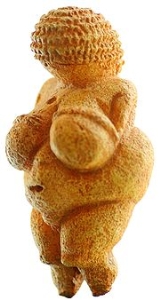WisdomandPower
Upon looking at the statue of the "Venus of Willendorf", it is obvious that she is of the voluminous lovely African-type of female physique, and her curly hair indicate the same. The original statue discovered in the early twentieth century was made of a type of limestone that is not readily available in the area of Austria where the statue was found. This suggests that people from the continent of Africa settled in the area, and this is why the statue has large breasts and hips. It is true that pregnant women do indeed have a protruding tummy, and menopausal women tend to gain weight and to have sagging breasts at the period of post-menopause. It seems, in conclusion, therefore, that the statue is indicative of either 1.) African people settling in this area that would one day be called "Austria" on the peninsula of Europe,and a sign of their reverence for the female, or 2.)a pregnant female, also of an African type or 3.) a menopausal female, but again of the African type. Archeologists and historians have shown that all of humanity arose from the "Oluvai Gorge" of East Africa (where the nations of Uganda, Kenya and Tanzania are now located)millions of years ago,and over time, these people moved into other parts of the world. The major scholars who have done work on this topic are Dr. Yosef ben Yochannan and Dr. Cheik Anta Diop. The former speaks and writes seven languages fluently and has five PHds. The latter passed on many years ago, but was of great renown. Other scholars of renown on the history of humanity and its journey throughout the world are Dr. Gerald Massey, Dr. Asa G. Hillard III and Dr. Marimba Ani. Massey and Hillard are gone from us, but Ani is still traveling, researching and writing. The "Venus of Willendorf" is a representative of a female ancestor of all of humanity as we have one earthly origin.


